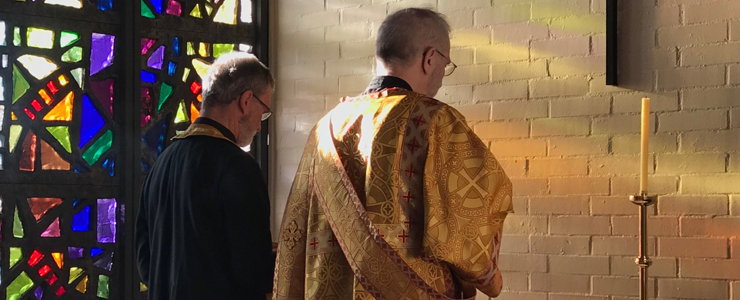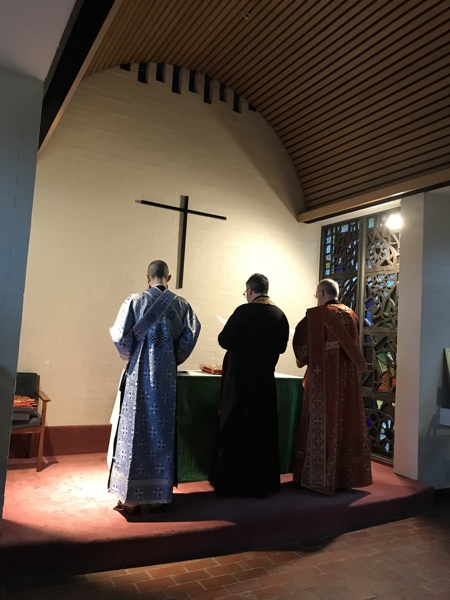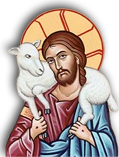Vespers
You are here

Come join us as we gather in God’s presence to welcome the new day.
Vespers — Saturday, 5:00pm
Held at the transition between liturgical days, Vespers is the first service in the normal weekly cycle.
Like all Orthodox worship, Vespers follows a common pattern which allows the congregation to be totally immersed. The service consists of psalms, prayers and spiritual songs. Like all Orthodox services, the atmosphere is calm and soothing, using only human voices to return praise and thanksgiving to God.
At The Good Shepherd, we are ably led in worship by a talented choir and dedicated clergy, and everyone is really welcoming.
If you’re not familiar with Orthodox worship, Vespers is the ideal service to attend first.
Details
All Vespers services are in the English language and are held in the Small Chapel of the Religious Centre at Monash University, Clayton Campus.
Parking in the University car parks is free on weekends (but please take note of all signs regarding Loading Zones, No Standing and Disabled Parking — these restrictions apply and are enforced — even at the weekends. Permit zones do not apply at the weekends but apply until 7pm every weekday.
For directions to the Religious Centre click here
What is Vespers all about?
Vespers is a multi-dimensional worship service whose ultimate purpose is to unite everyone and everything to Jesus Christ, starting with our own heart.
Time, timelessness and eternity
Unlike most Christian traditions, Orthodox worship is timeless. It’s not based on market research or personal preference. It has been handed down to us by our fathers in the faith. In turn we do our best to hand them to our spiritual children unchanged. The passing of worship from one generation to the next is called Tradition.

Fr. Tony, standing with Dcn. Nicholas and
Sub-deacon Timothy at Vespers
Spirit-inspired Tradition is good and proper and holy. Instead of seeking for something that appeals to us, we engage in something proven to work. And by “work,” we mean that it soothes us; heals us; nurtures and grows us in the life of God. We are transformed and conformed to the mind of Christ (Romans 12:2; Philippians 2:5–11).
But the timelessness of the service isn’t just limited to its unchanging character. The service is timeless because it transports us to the place where time and eternity meet.
The vesperal service does not begin as a religious “epilogue” of the day, as a prayer added to all the other experiences of the day. It begins at the beginning, and this means in the “rediscovery,” in adoration and thanksgiving, of the world as God’s creation.
The Church takes us, as it were, to that first evening on which mankind, called by God to life, opened their eyes and saw what God in His love was giving to them. They saw all the beauty, all the glory of the paradise-temple in which they were standing, and gave thanks to God. And in this thanksgiving they became themselves.
Praise the Lord, O my soul. Blessed are You O Lord …
O Lord, how manifold are Your works. In wisdom You have made them all.
The earth is full of Your riches.
I will sing to the Lord as long as I live, I will praise my God while I have my being
— Psalm 103, LXX
Vespers transports us to the very beginning, to see God through the eyes of unfallen mankind. And invites us to adopt God’s perspective of the entire saga that ensues.
When Vespers “works,” we discover the mindset that lets us reach beyond ourselves, so that we gradually become the person we were always meant to be.
Tracing the history of God’s worshiping people
During Vespers, we are present at the events from the time of Genesis onwards.
Psalm 103 which sings the praise of the creature to his Creator, returns to an age when humankind, not yet crushed by sin, could go joyfully to meet its God.
At the next stage, Psalms 129, 140, 141 mark the fall and the banishment from Paradise. The celebrant puts off his vestment, representing mankind as the naked and suffering man who cries outside of Paradise.
In the solitude, face to face with personal sin, the individual prays that the Lord will turn his face towards him or her anew:
“Lord, I have cried unto You.”
We are not “nice” Christians come apart from the ugly world. We stand as representatives of this world, bearing the whole burden of this day. We identify ourselves with the whole human condition, longing for healing and wholeness.
In this world, which rejected God and embraced chaos, there must be an anti-dote. There must be “someone” who can stand in its centre, to discern, to see it again as full of divine riches, as the cup full of life and joy, as beauty and wisdom, and to thank God for it.
Then God bends over the world and the mystery of this “someone” is revealed. The mystery of the Incarnation of God as man is proclaimed. The choir and the reader, in a dramatic dialogue in which the two Testaments meet, alternate in cries of distress and of joy at the promises.
There is a moving hymn attributed to the martyr Athenagoras (“O gladsome light”). The hymn takes us to the moment when Christ is revealed, and the world has once more seen the radiant light of the holy Glory of the Eternal Father.
Then with the song of Simeon, the humanity of the Old Testament disappears, giving place to that of the New Testament. Vespers finishes with the greeting of the Archangel to the Blessed Virgin Mary; the Saviour of the world rests in the arms of humankind.
Thus Vespers leads us towards the Divine Liturgy, where we, overflowing with thanksgiving, participate in communion with our God.
Prayer for the whole world
The vesperal litany teaches us the true relationship between the individual and the community, between the member and the body:
“Love your neighbour as yourself” — Mark 12:31
These words come to life, take us out of ourselves, and help us to make the prayer of humanity our own.
Here our own circumstances are embraced together with those of all people. The litany, like a powerful wave, draws the worshiper beyond self, beyond one’s family, out to the congregation present, then further out to those who are absent, those who are suffering and in pain, and the dying. Then the prayer encompasses those in holy orders, those in authority, town and country, nations and peoples, and finally the whole human race.
It asks for orderly seasons and abundance of the fruits of the earth. The prayer ends with the universal petition for peace and the unity of all.
Refreshed and renewed by the energetic charity of this communion, human beings rediscover the essential truth about themselves and the world around them. Solitude is abolished, and even nature, longing to be set free, bursts into cosmic liturgy.
Blessing God’s creation
The gap between the material and spiritual planes of existence seems to dissolve. As the deacon lifts his arms, the censer containing incense billows a fragrant smoke that extends his reach. His reach seems to gather the intentional energy of the congregation and directs it into communion. The fragrant incense reveals the presence of God.
During special feast days, the service includes a blessing of oil, wine and wheat, sanctifying the fertility of the earth and teaching human beings that the earth they cultivate is holy.
The uncreated God entered the created world and blessed it. So too, we, His people, stand alongside Him, blessing His creation.
Join us
Experience the Good News of Jesus Christ. Allow the peace of Christ to rest in your soul. Dissolve the barriers that divide one from another. Embrace the unity of communion in the Holy Trinity. Stand in the presence of the Divine, where you’re “who you’re meant to be” through becoming at-one with God, His creation, and all humanity.
For directions to the Religious Centre click here
References
This article is adapted from:
- Alexander Schmemann’s, “For the Life of the World,” St. Vladimir’s Seminary Press (2000), Chapter 6.
- Paul Evdokimov’s, “Orthodoxy,” New City Press (1979), pages 245, 246.

